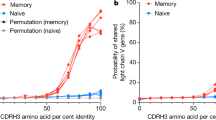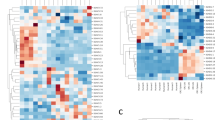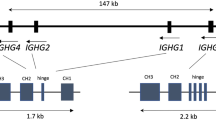Abstract
THE origin of antibody diversity is still unclear. Either the 104 to 108 different antibody specificities of the vertebrate immune system are completely encoded in germ line genes, or somatic mutations or recombination of a few genes contribute substantially to diversity. Both the large pool of specificities for single antigens and the very heterogeneous specificities among different individuals of inbred mouse strains (which are assumed to be genetically homogeneous) have led to somatic mutation theories. We have studied the immune response in Xenopus frogs which can be heterozygous and at the same time genetically identical. If there are many identical antibodies against several antigens in different individuals, somatic changes of genes coding for antibody specificities cannot be important for antibody variability in such animals. Antibodies to two different antigens have been assayed for by two techniques: inactivation of antigen-coupled phages by antibodies including inhibition of inactivation by free antigen; and isoelectric focusing (IEF). The results show low variability of antibody specificity, and often identical patterns among different individuals having identical genetic background.
This is a preview of subscription content, access via your institution
Access options
Subscribe to this journal
Receive 51 print issues and online access
$199.00 per year
only $3.90 per issue
Buy this article
- Purchase on Springer Link
- Instant access to full article PDF
Prices may be subject to local taxes which are calculated during checkout
Similar content being viewed by others
References
Kobel, M. R., and du Pasquier, L., Immunogenetics, 2, 87–91 (1975).
du Pasquier, L., and Wabl, M. R., Cold Spring Harb. Symp. quant. Biol., 41, (in the press).
Haimovich, J., and du Pasquier, L., Proc. natn. Acad. Sci. U.S.A., 70, 1898–1902 (1973).
Williamson, A. R., Eur. J. Immun., 1, 390–394 (1971).
Phillips, J. M., and Dresser, D. W., Eur. J. Immun., 3, 738–740 (1973).
du Pasquier, L., and Miggiano, V. C., Transplant. Proc., 4, 1457–1461 (1973).
Phillips, J. M., and Dresser, D. W., Eur. J. Immun., 3, 524–527 (1973).
Pink, J. R. L., and Askonas, B. A., Eur. J. Immun., 4, 426–430 (1974).
Kreth, H. W., and Williamson, A. R., Eur. J. Immun., 3, 141–147 (1973).
Köhler, G., Eur. J. Immun., 6, 340–346 (1976).
Author information
Authors and Affiliations
Rights and permissions
About this article
Cite this article
WABL, M., Du PASQUIER, L. Antibody patterns in genetically identical frogs. Nature 264, 642–644 (1976). https://doi.org/10.1038/264642a0
Received:
Accepted:
Issue Date:
DOI: https://doi.org/10.1038/264642a0
This article is cited by
-
Antibody diversity in lower vertebrates—why is it so restricted?
Nature (1982)
-
The expression of antibody diversity in natural and laboratory-made polyploid individuals of the clawed toad Xenopus
Immunogenetics (1982)
-
Hemoglobin transition in relation to metamorphosis in normal and isogenicXenopus
Wilhelm Roux's Archives of Developmental Biology (1977)
Comments
By submitting a comment you agree to abide by our Terms and Community Guidelines. If you find something abusive or that does not comply with our terms or guidelines please flag it as inappropriate.



